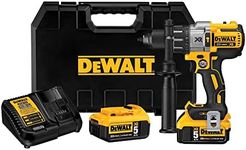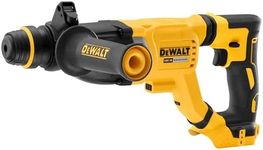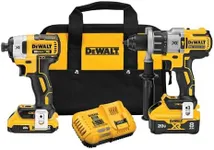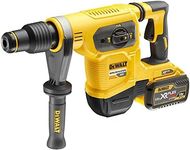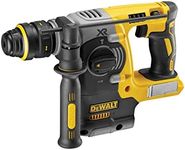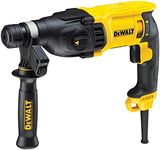Buying Guide for the Best Dewalt Hammer Drill
Choosing the right DeWalt hammer drill can make a significant difference in your DIY or professional projects. A hammer drill is a versatile tool that combines the functions of a regular drill and a hammering action to drill into hard materials like concrete, brick, and stone. To find the best fit for your needs, it's important to understand the key specifications and how they impact performance. Here are the main specs to consider when selecting a DeWalt hammer drill.Power (Voltage)The power of a hammer drill is typically measured in volts (V). This spec indicates the drill's ability to handle tough materials and demanding tasks. Higher voltage means more power. For light-duty tasks like drilling into wood or soft materials, a 12V drill may suffice. For more demanding tasks like drilling into concrete or masonry, a 20V or higher drill is recommended. Choose a power level that matches the intensity of your projects.
Speed (RPM)Speed, measured in revolutions per minute (RPM), determines how fast the drill bit rotates. Hammer drills often have variable speed settings, allowing you to adjust the speed based on the material you're working with. Lower speeds (0-500 RPM) are ideal for driving screws and drilling into softer materials, while higher speeds (up to 2000 RPM) are better for drilling into harder materials. Consider the range of materials you'll be working with to choose a drill with appropriate speed settings.
Hammering Rate (BPM)The hammering rate, measured in blows per minute (BPM), indicates how many times the hammer mechanism strikes the material per minute. A higher BPM means more efficient drilling into hard materials like concrete and masonry. For occasional use on softer materials, a lower BPM may be sufficient. For frequent use on hard materials, look for a drill with a higher BPM to ensure efficient performance.
Chuck SizeThe chuck size determines the maximum diameter of the drill bit that can be used with the drill. Common sizes are 1/2 inch and 3/8 inch. A 1/2 inch chuck is more versatile and can accommodate larger bits, making it suitable for heavy-duty tasks. A 3/8 inch chuck is lighter and more compact, ideal for lighter tasks and tight spaces. Choose a chuck size based on the types of projects you'll be undertaking.
WeightThe weight of the hammer drill affects its portability and ease of use. Lighter drills (around 3-4 pounds) are easier to handle and reduce fatigue during extended use, making them suitable for overhead or one-handed tasks. Heavier drills (5 pounds and above) offer more stability and power, which is beneficial for heavy-duty tasks. Consider the balance between power and comfort based on the duration and nature of your projects.
Battery LifeFor cordless hammer drills, battery life is a crucial factor. It determines how long you can use the drill before needing to recharge. Higher amp-hour (Ah) ratings indicate longer battery life. For occasional use, a lower Ah rating may be sufficient. For extended or intensive use, look for a drill with a higher Ah rating to ensure you can complete your tasks without frequent interruptions. Consider your usage patterns to choose the right battery capacity.
Additional FeaturesAdditional features like LED lights, ergonomic handles, and multiple speed settings can enhance the usability and convenience of the hammer drill. LED lights are useful for working in low-light conditions, ergonomic handles reduce strain during prolonged use, and multiple speed settings provide greater control over the drilling process. Think about the specific needs of your projects and choose a drill with features that will make your work easier and more efficient.


